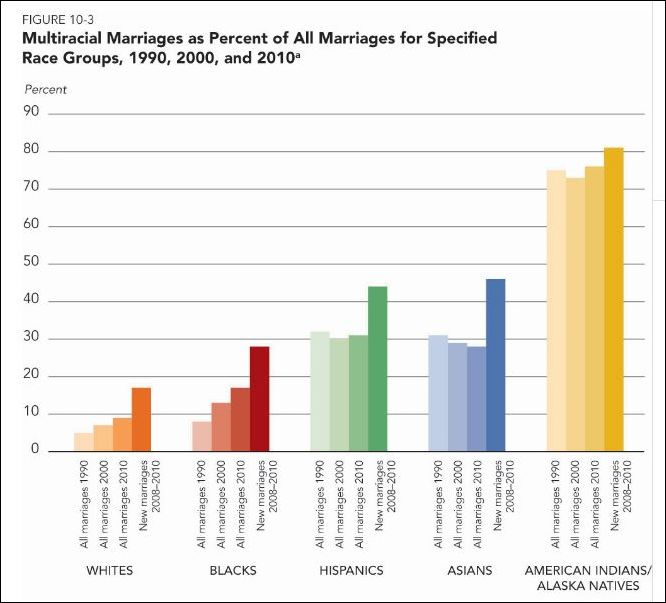With all the media attention on what divides the races — the Ferguson shooting, cop killings, voter ID, etc. — it’s easy to forget that in the world of everyday reality, race relations are actually improving. There’s no better proof of that than the spectacular increase in interracial marriage, as demonstrated by this chart compiled by William B. Frey with the Brookings Institution.
The racial divide between whites and American Indians has been largely obliterated, with 70% to 80% intermarriage rates since 1990. For all intents, American Indian identity is an ethnic identity, not a racial one. Here in Virginia, Indians are indistinguishable racially from whites. Meanwhile, the leap in intermarriage rates for Asians has been extraordinary — more than 45% of new marriages were interracial between 2008 and 2010. My conjecture: While first-generation Asians are likely to marry within their racial/ethnic group, for all practical purposes, there is no meaningful racial divide between whites and second- and third-generation Asians.
Intermarriage rates for Hispanics is almost as high as it is for Asians, and it is remarkably high even for blacks. For all the super-heated rhetoric about racial discrimination today, about 28% of all blacks marry people of other races. Writes Frey: “The fact that nearly three in 10 new black marriages are multiracial with most of them to white spouses reflects an important shift toward blurring a long-held color line in the United States.”
This data may exaggerate the intermixing of the races to some degree. It records intermarriage. Large percentages of all races do not get married. What we don’t know is the extent to which interracial cohabitation is a phenomenon as well. Nevertheless, insofar as marriage is predominantly a middle-class and professional-class phenomenon, it is safe to say that the racial divide is breaking down among more affluent Americans. It is also safe to say that as more Americans have parents of different races, more Americans will have difficulty classifying themselves as one race over another.
Bacon’s bottom line: Could America be evolving toward a “Caymanian” racial model? One of the most fascinating laboratories for race relations in the world was the tiny island of Grand Cayman. The scrubby coral island was settled by a handful English settlers and black slaves. The rocky soil was too poor to support plantations, so the racial divide was never as stark as it was in nearby Haiti or Jamaica. After Great Britain emancipated the slaves, whites and blacks lived side by side in an egalitarian subsistence economy. Inhabitants eked out a living through fishing and working tiny farms, supplemented by work as merchant mariners. Intermarriage was rampant. By the time the island opened up to the broader world in the 1960s, there were no pure white Caymanians or pure black Caymanians. Even Caymanians who looked mostly white often had dark-skinned cousins. When I spent a summer there as a lad in the 1960s, the island quite possibly had the most egalitarian race relations on the planet.
The population of native Caymanians has been swamped by the influx of poor black Jamaicans and wealthy white Europeans, so race relations likely has changed since then. But when I think of where America is heading, I think of Grand Cayman, circa 1968. The United States is a bigger mixing bowl, and there are more flavors (East Asian, South Asian, American Indians, mestizo Hispanics), and we’ll see more lumpiness, but the end result will be very similar.
— JAB



